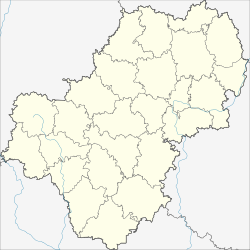Borovsk
| city
Borovsk
Borovsk
|
||||||||||||||||||||||||||||||||||||||||
|
||||||||||||||||||||||||||||||||||||||||
|
||||||||||||||||||||||||||||||||||||||||
| List of cities in Russia | ||||||||||||||||||||||||||||||||||||||||
Borowsk ( Russian Боровск ) is a city in the Kaluga Oblast ( Russia ) with 12,283 inhabitants (as of October 14, 2010).
geography
The city is located about 100 km north of the Oblast capital Kaluga on the Protwa , a left tributary of the Oka, which flows into the Volga .
Borovsk is the administrative center of the raion of the same name .
history
According to the results of excavations from 2003, the place has existed since the 13th century. It was first mentioned in a document of Ivan II in 1358 as the city of Borovesk . During this time it was administered by feudal lords of the Principality of Chernigov , and later of the Principality of Ryazan . The place name is derived from the Russian word bor for forest , especially pine forest .
In 1382 the city became part of the Grand Duchy of Moscow . In 1444 a monastery was built nearby, which was named after the later canonized founder Borovsk Pafnuti Monastery ( Боровский Пафнутьев монастырь / Borowski Pafnutjew monastyr). This is where the icon painter Dionysius created his earliest known works towards the end of the 15th century .
In the time of turmoil at the beginning of the 17th century, the city was highly competitive. From the end of the 17th century, Borowsk developed into one of the centers of ancient orthodoxy . The archpriest Avakum and the boyaress Feodosiya Morosova were imprisoned here.
During the Patriotic War of 1812, the town and monastery were looted and burned down by French troops. In 1857 Borovsk was again badly affected by a fire.
During the Second World War , Borovsk was occupied by the German Wehrmacht on October 15, 1941 and recaptured on January 4, 1942 by the Western Front of the Red Army during the counterattack in the Battle of Moscow .
Population development
| year | Residents |
|---|---|
| 1897 | 8,414 |
| 1926 | 5,800 |
| 1939 | 10,255 |
| 1959 | 10,897 |
| 1970 | 12,297 |
| 1979 | 13,578 |
| 1989 | 13,405 |
| 2002 | 11,917 |
| 2010 | 12,283 |
Note: census data (1926 rounded)
Culture and sights
On the outskirts of Borowsk is the Pafnuti Monastery , which was restored to a history and architecture museum after destruction in the 20th century from the 1960s and has been in the possession of the Russian Orthodox Church again since 1991 . The main church is the Cathedral of the Mother of God ( Рождественский собор / Roschdestwenski sobor), which was built from 1586 using material from a church of the same name from 1467, partly with frescoes by Dionysius. The small Elias Church ( Ильинская церковь / Iljinskaja zerkow) from 1670 and others are also located in the monastery ; the refectory from the 16th century and the monastery wall with defensive towers have also been preserved.
In the city itself there is the Boris and Gleb Church ( церковь Бориса и Глеба / zerkow Borissa i Gleba) from 1704 with a high bell tower from 1819. An old Orthodox memorial chapel was rebuilt at the presumed location of the imprisonment and death of Boyarin Morozova and the Princess Urusova. There are also other churches, some of which have not yet been restored, in Borovsk and the surrounding area.
There is a Tsiolkovsky museum apartment in Borovsk .
Economy and Infrastructure
In Borovsk there are companies in the textile and wood processing industries (matches, toys) and, more recently, a factory for small trucks.
The nearest train station is in the town of Balabanowo, about twelve kilometers to the east, on the Moscow - Bryansk - Kiev railway line opened in 1899 (route km 96).
The highway A108 , the Great Moscow Ring , passes about six kilometers northeast of Borovsk.
Personalities
- Andrei Amalrik (1938–1980), historian, writer and dissident ; Before leaving the Soviet Union in 1976, he was exiled to Worsino near Borowsk
- Konstantin Chrenow (1894–1984), metallurgist, welding pioneer and university professor
- Nikolai Fyodorow (1829–1903), philosopher, educator and religious thinker; lived in Borowsk in the 1850s and 1860s and taught at the Semstvo School
- Nikolai Klykov (1888–1968), general, born in Borovsk
- Feodossija Morozova (1632-1675), Bojarin and supporter Awwakums ; was imprisoned with her sister, Princess Urussowa, from 1674 in the Borowsk Ostrog , where both starved to death; is venerated as a saint by the Old Orthodoxy
- Dmitri Senjawin (1763-1831), admiral ; born on family estate near Borowsk
- Pafnuti Chebyshev (1821–1894), mathematician; born in Okatowo, district (Ujesd) Borowsk
- Konstantin Ziolkowski (1857–1935), space pioneer ; lived in Borowsk from 1880 to 1892 and worked here as a teacher
Web links
- Borovsk on mojgorod.ru (Russian)
Individual evidence
- ↑ a b Itogi Vserossijskoj perepisi naselenija 2010 goda. Tom 1. Čislennostʹ i razmeščenie naselenija (Results of the All-Russian Census 2010. Volume 1. Number and distribution of the population). Tables 5 , pp. 12-209; 11 , pp. 312–979 (download from the website of the Federal Service for State Statistics of the Russian Federation)






